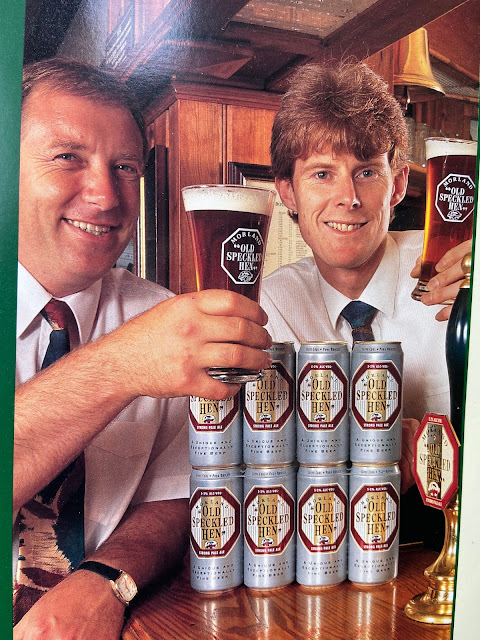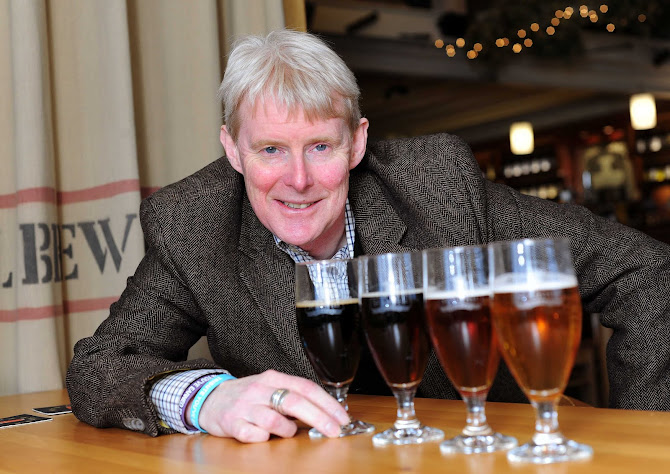 |
| Morland Marketing Manager Gerald Pridmore left, with Marc Bishop right |
I've often touched on my association with Old Speckled Hen in previous blogs but have never told the story of the brand and how it came to success in its early years. Of course, today Old Speckled Hen (or OSH as I shall refer to it) is well known as the flagship beer brand amongst the Greene King Brewery fleet of ales, but it began life quite differently and was ground breaking in its day. For me personally, having the chance to work on the brand gave me much learning and a life long career in beer marketing so I've much to be grateful for.
Life Begins at 50!
Old Speckled Hen began life as a commemorative beer, brewed by Morland Brewery in Abingdon in association with the towns famous MG plant to celebrate its 50th birthday. It was originally first brewed in 275ml bottles at 5.2%abv and quickly developed a reputation locally as a good beer, mostly being available in Morland pubs.
Because of the 50th birthday link the beer was brewed at 1050 Original Gravity, which will usually generate a beer of around 5% abv. Then Head Brewer, Bill Mellor, who created the beer says he simply wanted to brew a beer of that gravity with an appropriately full colour and flavour but with a dryness and easy drinkability. Morland used a two strain yeast, originally believed to have come from Charringtons Brewery, London that gave their then house beer, Morland Bitter a distinctive dryness that could even be astringent - it was a great beer once you got the taste for it. When this yeast was used for OSH, the natural full sweetness of the stronger beer perfectly balanced the dryness of the yeast to create a very drinkable strong beer.
 |
| Morland Head Brewer Bill Mellor left, with Technical Brewer Andrew Bowes right |
The unique name remembered an old MG motor car - in the mid 1920's the MG plant used to experiment with new paint schemes and this particular car was painted black with flecks of gold paint. The new paint scheme was not a success so the car was used as a factory run-around, where when seen on its travels by the locals was referred to in their broad Berkshire accents as the Ow'd Speckled Un. Hence, when MG were looking for a unique name for the new beer Old Speckled Hen was born.
Sadly, the MG plant in Abingdon closed within 18 months of the new beer coming out so Morland were left with a rather nice bottled beer but no factory of local workers to champion it!
 |
| The original MG car, the Ow'd Speckled Un |
Opportunity knocks
OSH continued as a bottled beer until the later 1980's by which time sales had declined and its future was in doubt. However, an opportunity combined and never has it been so true with the old adage, right place, right time etc.
Firstly, the Monopolies and Mergers Committee reported into the beer industry with what would turn out to be far reaching changes and alter the brewing and pubs landscape forever. One of the recommendations was that national brewers, all of whom had large pub estates must allow their pubs to offer a guest cask beer. Secondly, Morland had a failing lager brand called Kaltenberg Braumaster (see my other blog for the story), that already had a sizeable marketing budget of £100,000 per annum. Thirdly and perhaps most importantly, the then marketing manager, a very clever man called Gerald Pridmore, was bright enough, bold enough and risk tolerant to take advantage of this situation.
Morland never had a cask beer suitable to make great strides as a guest beer so they would need to invent one, but Gerald saw the opportunity and duly worked with Bill Mellor to introduce Old Speckled Hen on draught. A new brand also needs a marketing budget so Gerald took a risk and unbeknown to the then CEO, used the existing marketing budget set aside for Kaltenberg to put the building blocks in place for OSH.
Gerald was a lone marketeer in 1990 and needed a number two and it was then that I joined the team shortly after cask OSH had been test marketed - Gerald always said he knew it would be a success when in one of the test pubs, the locals were drinking the beer slops, so good was the flavour. It was then we began to put the marketing support in place for the new brand.
Firstly, the pump clip, We never used an advertising agency for the design, it was done by Gerald and the pump clip supplier (Objex of Abingdon). It was was a quality octagon shaped enamel printed brass clip that felt heavy in the hand. I recall Gerald placing a small MG logo that he'd cut out from a magazine in the centre front of the proof pump clip that was to become part of the final clip design. A little cheeky maybe, but the bottle label had the logo so it was a risk worth taking. The MG connection gave the brand initial credibility, although it was later rightly removed as OSH developed its own personality. Secondly, in marketing terms OSH would have some "firsts" for a regional brewers ale brand - our famous starter kit and advertising in the trade press.
 |
| An original OSH pump clip showing the MG logo |
All pubs who first stocked OSH received a starter kit, containing a pump clip, bar towels, drip mats, a show card telling the brand story and most importantly some quite unique pint glasses. Including the pump clip in the starter kit sounds so obvious but at the time hand written paper/card pump clips for guest beers were sadly a common sight in many pubs for guest beers. Glassware too was was really important as it set the OSH drinker aside and reinforced the brands premium image.
Large scale trade advertising was a first for a regional ale brand and stimulated demand for the new beer. The ads were very different and again it was all about quality - we even listed wholesaler supplier names on the ads who were always keen to stock the brand as it created demand for them as well as us. This culminated in Morland receiving the Best Trade Advertising Campaign Award from the Publican and Morning Advertiser in 1994.
 |
| OSH Trade Avert |
The mid 1990's and beyond
OSH was now beginning to fly. Licensees loved stocking it as it came with a strong marketing package that gave them the confidence it would sell off the bar. Consumers also loved the flavour, people were looking for stronger beers and the premium aura of the pump clip and the glass all felt a little bit special.
The brewing team had now got a handle of brewing consistency - the abv was known to fluctuate and at a time when it was common place to enjoy a couple of pints at lunchtime, OSH could be over 6% abv in reality, so no wonder work efficiency suffered in the afternoons! Investment had also taken place in a new brewery, logistics and packaging. Bill Mellor had taken an honourable and much deserved retirement and a new Head Brewer, Steve Calderbank was appointed. Morland were now equipped to grow the brand into the 21st century.
 |
| The new Morland Brewhouse |
Morland had a strong sales team led by Sales Director Paul Bence who really believed in the brand, plus there were no competitor brands within Morland's portfolio so everyone was wholly focused on OSH - a really important advantage when it comes to brand building. I also remember Gerald being challenged by the CEO that sales of OSH would only ever be one firkin (9 gallon cask) per week on average in pubs and was that worth bothering as volumes per pub would be so small. His answer was that we simply needed more stockists and he was right - it was common place for the larger wholesale depots to be ordering up to 500 x 9 gals per week.
By this time OSH had now been launched in a new 500ml clear glass bottle. Again a first, introduced by the new Commercial Director Rupert Thompson that would lead to OSH becoming the leading Premium Bottled Ale for sales in supermarkets for many years. A relationship with the Charles Wells brewery saw cans introduced building the OSH name further.
 |
| Morland Senior Management team at opening of new brewery. L to R, Rupert Thompson, Michael Watts, Martin May Smith, Steve Calderbank (Head Brewer), Peter Furness-Smith, Paul Rivers. |
However, all was not rosy for Morland, as a public company they were always susceptible to a takeover bid from another brewer, especially now they owned a desirable ale brand in growth along with a valuable large pub estate in the Thames Valley. Greene King duly came knocking in 1992 and although they received their marching orders on their first attempt, a second was to prove successful in 2000 and the brewery in Abingdon was closed with production of OSH moved to their Bury St Edmunds Brewery.
I'm pleased to say that under Greene King OSH has continued to prosper and is now established as a consistent top five Premium Bottled Ale. In truth, Morland had probably reached their limit in growth capability for OSH and the bigger brewer was able to give the brand that extra support and investment taking it to the next level. In todays market although still very popular, it is not considered very exciting and old fashioned compared to many of the new craft beers and innovation in beer styles. However, for me personally it is a brand I am very proud of and thoroughly enjoyed working on. It gave me the chance to work with some lovely people and led to a great career in beer marketing.
Thank you and raise a glass to the Ow'd Speckled Un!
Source:
Independent - Michael Jackson article, 2/1/93
Marc Bishop own archives
